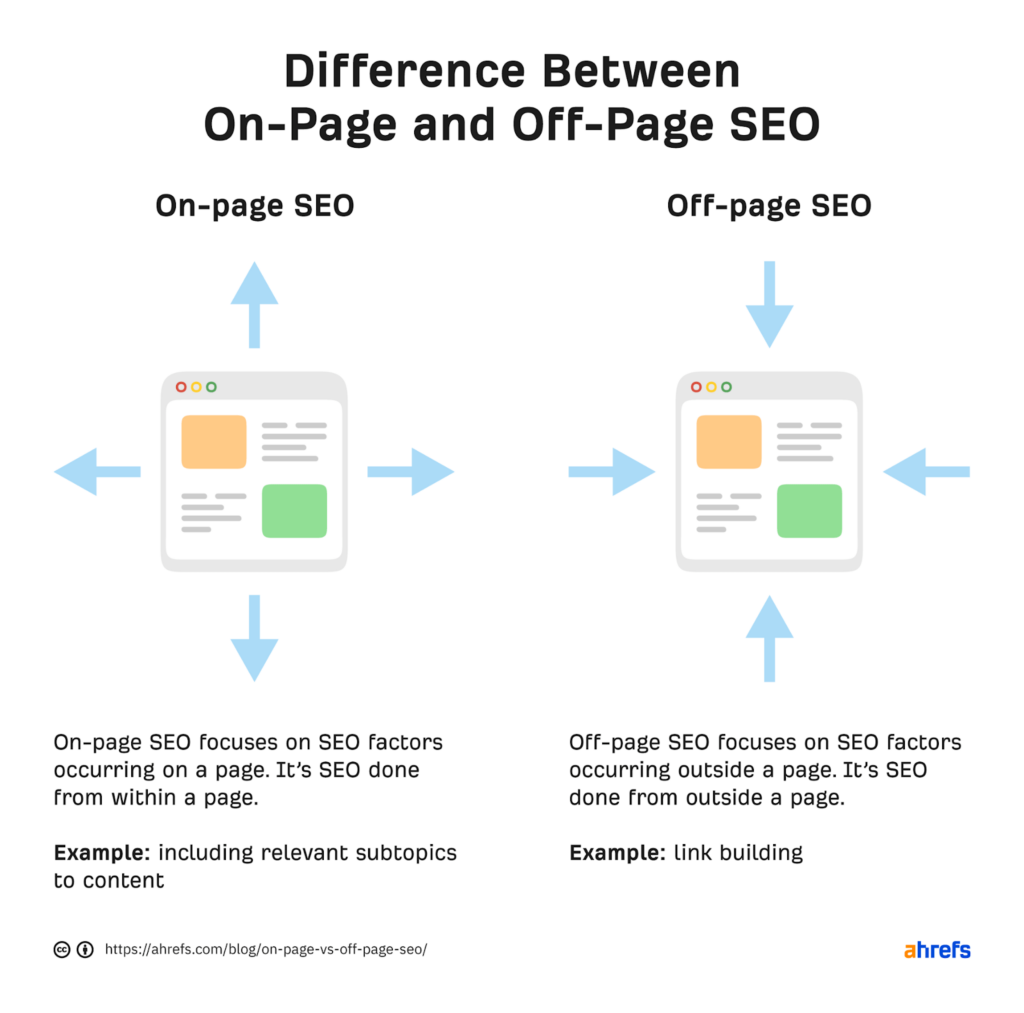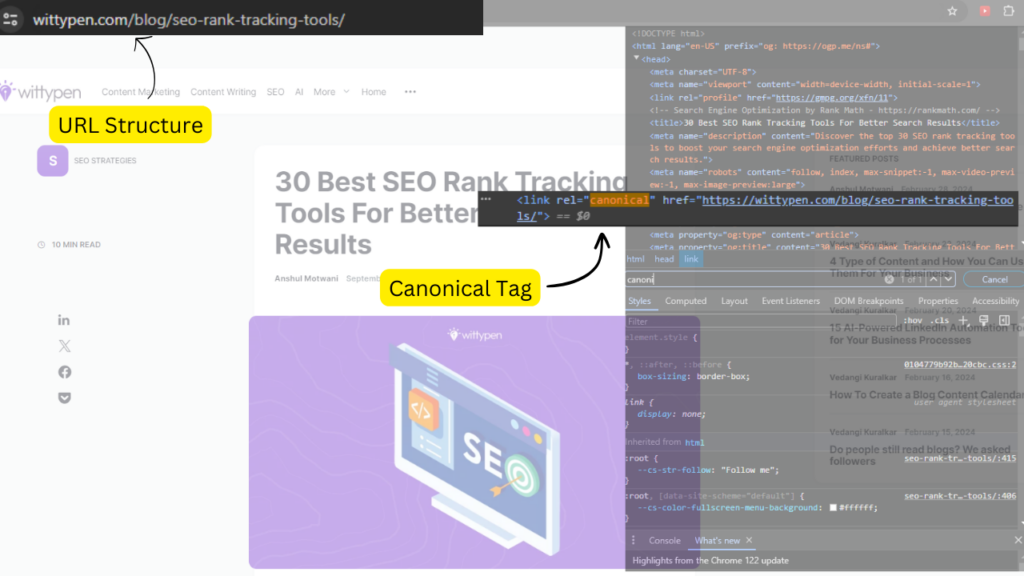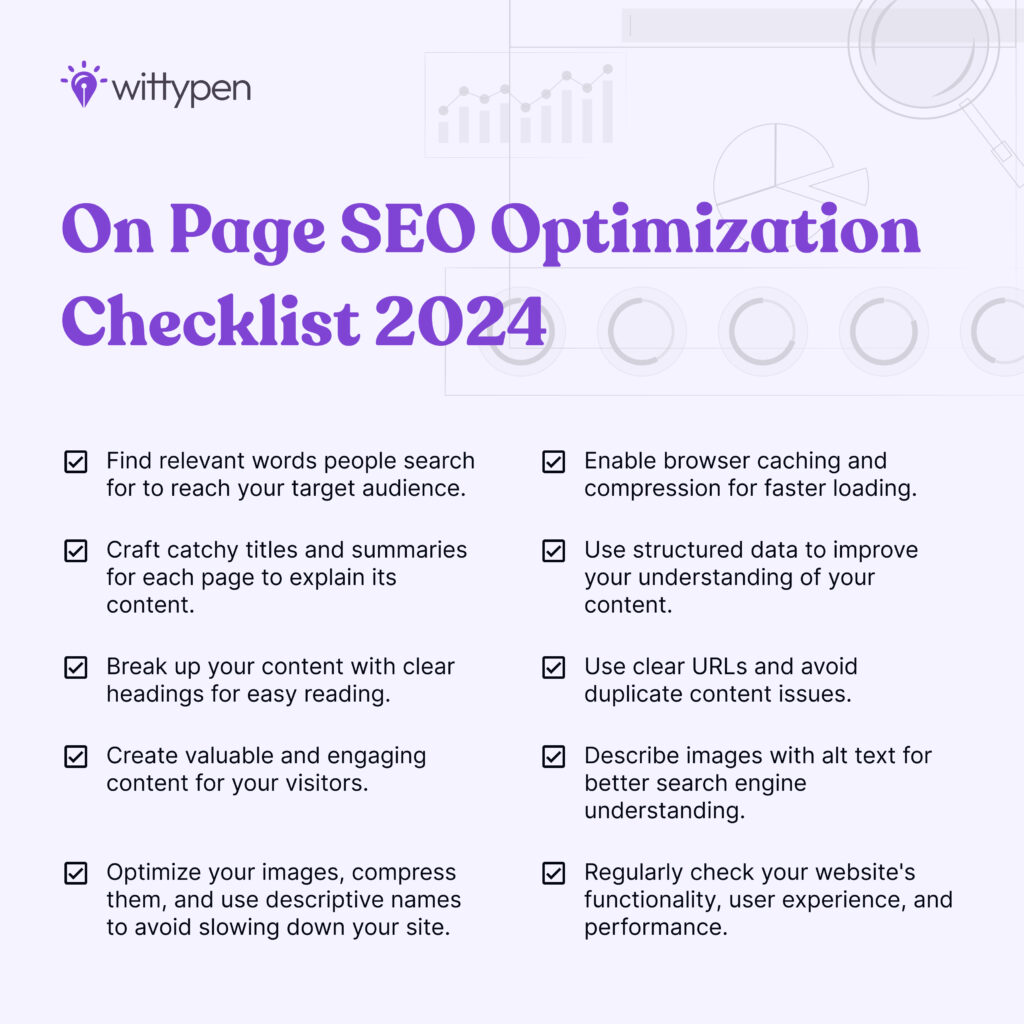Last updated on May 8th, 2024
If you’re looking to boost your website’s visibility and dominate the digital space, on-page SEO is the game-changer you need in 2024.
Think of it like this: On-page SEO is like the magic touch that makes your website shine brightly in the big online world. It’s like a magnet that effortlessly pulls in the people you want to reach.
But how do you effectively use on-page SEO to make your website stand out? Don’t worry, it’s not as tricky as it sounds. As things change on the internet, so do the tips and tricks for success.
In this post, we’ll share the latest tips and tricks to help your website not just keep up but also stand out. Here is a complete on-page SEO checklist:
Table of Contents
- What Is On-Page SEO?
- On-Page SEO Vs. Off-Page SEO
- Where to Start the On-Page SEO Activity?
- How to Master the On-Page SEO Strategy? 11 On-Page SEO Techniques
- 1. Page Speed Optimization
- 2. Mobile Optimization
- 3. Schema Markup and Structured Data
- 4. URL Structure and Canonicalization
- 5. Keyword Research and Optimization
- 6. Creating High-Quality Content
- 7. Title Tags and Meta Descriptions
- 8. Heading Tags and On-Page Formatting
- 9. Optimizing User Interface and Navigation
- 10. Call-to-Action Optimization
- 11. Engaging Multimedia Content
- Top Metrics to Measure Your Efforts
- On-Page SEO Checklist to Follow
- Summing Up
What Is On-Page SEO?
On-page SEO (also known as on-site SEO) refers to the practice of optimizing various elements of your website. This helps to improve its search engine ranking and user experience. It involves tweaking different parts of your webpage to boost its chances of ranking higher in search results.
To master on-page SEO, you’ll need to focus on optimizing key elements. This includes fine-tuning your content with relevant keywords, improving your site’s speed, and ensuring it’s visually appealing on mobile devices.
In essence, the idea is to make your website as user-friendly and search engine-friendly as possible.
What Does On-Page SEO Include?
When it comes to on-page SEO, there are crucial factors to consider.
- At the forefront is content SEO on-page optimization, which emphasizes the creation of top-notch content that resonates with your audience and incorporates relevant keywords.
- Next up is optimizing your HTML tags, like your title tags and meta descriptions, to make them more informative and enticing. It’s equally important to pay attention to your site’s structure to ensure seamless navigation for both users and search engines.
- In addition, on-page SEO success hinges on factors like page speed, mobile responsiveness, and internal linking. Each of these elements plays a significant role in optimizing your on-page SEO effectively.
On-Page SEO Vs. Off-Page SEO
On-page SEO and off-page SEO are like two sides of the same coin, each playing a crucial role in improving your website’s visibility and authority.
On-page SEO focuses on optimizing on-page SEO factors directly on your website, like content and HTML tags. Off-page SEO looks at external SEO on-page factors, like backlinks and social signals. Both are important for achieving higher rankings in search results, but they require different strategies and tactics.
With on-page SEO, you might focus on creating high-quality content incorporating relevant keywords and optimizing your site’s structure for better navigation.

On the other hand, off-page SEO might involve reaching out to other websites and influencers in your industry to build backlinks to your site and increase your online presence.
Ultimately, combining on-page and off-page SEO is vital to achieving long-term success in improving your website’s search engine visibility and driving more organic traffic.
Below is a table highlighting the key distinctions:
| Aspect | On-Page SEO | Off-Page SEO |
| Factors Controlled | Within the Website | External to the Website |
| Examples | Content Quality, Title Tags, Header Tags, URLs, Internal Linking, Page Speed, Mobile Responsiveness | Link Building, Social Signals, Brand Mentions, Local SEO Events, Guest Posting |
| Impact on Rankings | Direct | Indirect |
| Tools Used | Google Search Console, Google Analytics, Yoast SEO Plugin, WittyPen | MozBar, Majestic SEO, Ahrefs, BuzzSumo, HARO |
| Main Objective | Improve Relevance & User Experience | Build Authority & Relationships |
By understanding the differences between on-page SEO and off-page SEO, you can develop a comprehensive SEO strategy that leverages both to improve your website’s visibility and ranking on SERPs.
Where to Start the On-Page SEO Activity?
Beginning your on-page SEO journey requires setting a solid foundation for your website’s success. Before diving into more advanced techniques, take the initial step by utilizing the following tools.
Below are some resources to help assess your website’s current status and identify specific areas that require improvement:
Wittypen Free SEO Checker
Take advantage of our free tool designed to provide personalized suggestions tailored to improving your website’s on-page SEO. It offers insights and tips based on industry best practices, which makes it easier for you to optimize your site.
You can input your blog or the published URL and the keyword that you want the page to be optimized for. In one click, Wittypen’s On-Page SEO Checker will analyze the content and give you results on what is working for your page, what can be improved, and what areas are critical to fix for a better ranking.
Google Search Console
Google Search Console is your go-to for monitoring your website’s performance, checking its index status, and identifying any crawl errors that might be hindering your SEO efforts.
Google Analytics
Google Analytics lets you understand your visitors’ behavior, track conversion rates, and assess the effectiveness of your SEO campaigns. This valuable data will guide you in making informed decisions to enhance your website’s performance.
How to Master the On-Page SEO Strategy? 11 On-Page SEO Techniques
Implementing effective techniques enhances your website’s search engine rankings, user experience, and overall online presence.
Here’s a concise list of on-page SEO optimization techniques you can follow in 2024:
- Page Speed Optimization
- Mobile Optimization
- Schema Markup and Structured Data
- URL Structure and Canonicalization
- Keyword Research and Optimization
- Creating High-Quality Content
- Title Tags and Meta Descriptions
- Heading Tags and On-Page Formatting
- Optimizing User Interface and Navigation
- Call-to-Action Optimization
- Engaging Multimedia Content
Let’s explore each technique in more detail:
1. Page Speed Optimization
Page speed optimization is a vital on-page SEO technique to enhance your website’s loading times for an improved user experience and search engine rankings. Slow loading speeds can deter visitors, leading to higher bounce rates and decreased visibility in search results.
- Make sure to reduce file size by compressing photos and videos without sacrificing quality. Smaller files download more quickly, keeping visitors interested and lowering bounce rates.
- You can also remove characters and whitespace from your code to make it lighter and faster to load. A cleaner, more concise code means less data for the browser to process, which results in faster page loads.
- Focus on enabling caching to keep frequently visited data locally. It helps with faster subsequent visits. Keeping items like photos and scripts on the user’s device eliminates the need to download them repeatedly.
- Defer the loading of non-essential resources until they are required, prioritizing crucial content. This prioritizes the components that visitors see first. It results in a speedier initial page load and a more seamless surfing experience.
- Use a CDN to spread content across numerous servers, lowering latency and improving loading times.
Implementing these strategies can significantly enhance your website’s page speed, leading to better user engagement and higher search engine rankings.
2. Mobile Optimization
Mobile optimization is another crucial on-page SEO optimization tactic focused on tailoring your website’s design and content for optimal performance on mobile devices.
Phone shopping reigns supreme, with over 70% of online purchases made using smartphones. Given the rising trend of mobile browsing, ensuring your site is mobile-friendly is essential for delivering a seamless user experience.
To optimize your website for mobile devices,
- Adapt to different screen sizes with ease to meet the needs of a wide range of mobile devices. This helps to provide a user experience that is free from annoyance.
- Focus on adding big, readable fonts make reading easier on smaller mobile screens. Doing so reduces eye strain and encouraging the consumption of content.
- Make sure to compress your images and videos, as it helps with the loading time of the page.
- Mobile devices incorporate a streamline navigation system. Users can find information quickly, which will require fewer clicks.
- Optimizing your website for mobile devices improves the user experience, reduces bounce rates, and enhances search engine visibility.
3. Schema Markup and Structured Data
Schema markup and structured data are essential on-page SEO techniques designed to provide search engines with additional context about your website’s content.
Incorporating schema markup and structured data can enrich search result snippets and boost click-through rates (CTRs).
Here’s how to implement them effectively:
- Enhance content details like ratings, reviews, and pricing with schema markup to provide search engines with valuable information.
- Implement structured data to make sure it offers search engines deeper insights into your website’s content and organization.
- Use Google’s Structured Data Markup Helper to generate structured data code for your site and test it with the Structured Data Testing Tool to ensure proper implementation.
Integrating schema markup and structured data can elevate your website’s search engine visibility and encourage higher user engagement.
4. URL Structure and Canonicalization
URL structure and canonicalization are vital for on-page SEO, influencing how search engines interpret and index your website’s content.

A well-organized URL structure aids navigation for users and search engines alike, while canonicalization helps designate the preferred version of a webpage with similar or duplicate content.
Here are some strategies you can follow:
- Make sure to create user-friendly URLs containing relevant keywords. Clearly communicate page content to users and search engines.
- Always use hyphens to separate words. Improve the readability and understanding of your URL structure.
- It is best to avoid special characters, numbers, and excessive parameters. Maintain URLs that are clean and easy to remember.
- Always focus on implementing canonical tags. Specify the preferred version of a webpage to avoid confusion and improve SEO.
- Audit your website for duplicate content on a regular basis and implement redirects as needed. Maintain a clean and efficient website structure for the best search engine performance.
Refining URL structure and canonicalization enhances crawl ability, indexation, and overall SEO performance.
5. Keyword Research and Optimization
Keyword research and SEO on-page optimization are fundamental to on-page SEO, involving the strategic integration of relevant keywords into your website’s content to boost search engine visibility.
Here’s what you can follow to excel at it:
- Keyword research is the first step in the process. This involves identifying relevant keywords and inserting them smartly into your blog. These keywords can be classified as small-tail and long-tail keywords. Utilize tools like Google Keyword Planner, SEMrush, or Ahrefs to identify pertinent keywords.
- Target specific, long-tail keywords with lower competition and high relevance to your audience. The majority of Google searches are long-tail keywords, which are more specific and detailed search terms.
- Incorporate primary keywords into titles, headings, meta descriptions, and content.
- Steer clear of keyword stuffing, prioritizing engaging, value-driven content.
- Track keyword performance using analytics to gauge rankings, traffic, and conversions.
Through meticulous keyword research and on-page SEO optimization, you can effectively elevate your site’s visibility and attract organic traffic.
 Let’s take a closer look at this specific example. We optimized a blog post for the keyword “30 best SEO rank tracking tools.”
Let’s take a closer look at this specific example. We optimized a blog post for the keyword “30 best SEO rank tracking tools.”
By strategically integrating this keyword throughout the content, from the title and headings to the body itself, we could signal the blog post’s precise topic and target audience to search engines.
This strategic approach, coupled with other SEO best practices, has yielded impressive results.
This example showcases the effectiveness of keyword optimization in driving organic traffic and achieving top search engine rankings.
6. Creating High-Quality Content
Now, let’s explore what on-page SEO is in relation to content creation. High-quality content is pivotal to successful on-page SEO strategies, enticing visitors, fostering engagement, and establishing authority in your niche. To create compelling content:
- Focus on conducting thorough research to ensure your content offers valuable insights and information.
- Make sure to craft a captivating headline that grabs attention and encourages clicks.
- To enhance readability, always organize your content with clear headings, subheadings, bullet points, and visuals.
- Zero in on naturally integrating relevant keywords to increase search engine discoverability.
- Key in on regularly updating your content to maintain its relevance and accuracy.
Consistently producing high-quality content aligned with user needs and search intent strengthens credibility, drives organic traffic, and enhances overall search engine performance.
Google prioritizes three key factors when determining search rankings: high-quality content, a positive user experience on the page, and quality backlinks from other websites.
7. Title Tags and Meta Descriptions
Title tags and meta descriptions play vital roles in on-page SEO, offering summaries of your web page’s content to search engines and users. To optimize:
- Craft descriptive and compelling titles that accurately depict your page’s content.
- Keep titles under 60 characters for full display in search results.
- Write meta descriptions that provide concise summaries of the page’s content, including relevant keywords.
- Limit meta descriptions to 155 characters for complete visibility.
- Avoid duplicating title tags and meta descriptions across multiple pages.
By optimizing these elements, you can enhance your website’s click-through rates and search engine visibility.
Try out our free tool to generate engaging meta titles and meta descriptions for your content.
8. Heading Tags and On-Page Formatting
Heading tags and on-page formatting are crucial for on-page optimization, organizing content, and enhancing readability. To optimize:
- Use H1 tags for the main title and H2-H6 tags for subheadings, incorporating keywords naturally.
- Employ bullet points, numbered lists, and other formatting elements to break up content and enhance readability.
- Integrate relevant keywords into headings and subheadings.
- Utilize images and videos to enrich user engagement and provide visual interest.
- Ensure the content is well organized and easy to navigate.
Optimizing heading tags and on-page formatting improves the user experience, engagement, and search engine visibility.
9. Optimizing User Interface and Navigation
Optimizing the user interface and navigation is a critical on-page SEO technique involving designing a clean, intuitive interface and navigation system. This enhances visitors’ ability to locate desired information, reducing bounce rates, improving engagement, and enhancing search engine visibility. To optimize:
- Utilize a clean, modern design aligned with your brand and audience preferences.
- Ensure easy navigation, allowing visitors to find information quickly.
- Provide clear and descriptive labels for navigation links and buttons.
- Implement breadcrumbs for clear navigation paths back to previous pages.
- Utilize internal linking to connect related content and improve navigation flow.
By optimizing the user interface and navigation, you can elevate the user experience, reduce bounce rates, and improve search engine visibility.
10. Call-to-Action Optimization
Regarding getting people to take action on your website, call-to-actions (CTAs) are like friendly nudges in the right direction. Here’s how to make them work better:
- Center your focus on putting your CTAs where people can see them immediately, ideally at the top of your page.
- Always keep your CTAs simple. Tell users exactly what action you want them to take, whether signing up or buying.
- Work on using eye-catching colors or bold text to ensure your CTAs are visually appealing.
- Consider tailoring your CTAs to different visitor types based on their behavior or preferences.
- Evaluate and experiment with different versions of your CTAs to see what works best and optimize for improved results.
By sprucing up your CTAs, you can boost user engagement, increase conversions, and make your website shine.
11. Engaging Multimedia Content
Adding fun stuff like pictures, videos, and podcasts to your website can make it a lot more enjoyable for visitors. Here’s how to do it right:
- Make sure to use high-quality images and videos relevant to your content and visually appealing to your audience.
- Ensure your images and videos load quickly to avoid frustrating your readers with slow loading times.
- Direct your efforts towards creating informative and visually appealing infographics to break down complex information clearly and concisely.
- Concentrate on sharing interesting and informative podcasts related to your audience’s interests.
- Share your content on social media platforms to reach a wider audience and increase engagement.
Adding fun stuff to your website can make it more fun to visit, keep people interested, and bring in more visitors.
Top Metrics to Measure Your Efforts
To see if your on-page SEO optimization efforts are paying off, you need to keep an eye on some important numbers.
Here are the key metrics you can follow to track your progress and determine the success of your on-page SEO optimization efforts:
- Check how much traffic is coming to your site from search engines. More traffic usually means your SEO is working.
- See how many people leave your site after only looking at one page. A high bounce rate could mean your content isn’t grabbing their attention.
- Find out how long visitors stick around on your site. Longer dwell times suggest they’re finding what they need and liking what they see.
- See how many pages people view in one visit. The more pages they visit, the more engaged they are with your content.
- Measure how many visitors take the action you want them to, like signing up or buying something. A higher conversion rate means your site is convincing people to do what you want.
- Check how many people click on your site when they see it in search results. A higher CTR means your site’s title and description are appealing to users.
- Keep an eye on where your site shows up in search results for important keywords. Climbing up in rankings means your SEO efforts are paying off.
On-Page SEO Checklist to Follow
To make sure your website is in tip-top shape for search engines, go through this checklist:
- Find relevant words people search for to reach your target audience.
- Craft catchy titles and summaries for each page to explain its content.
- Break up your content with clear headings for easy reading.
- Create valuable and engaging content for your visitors.
- Optimize your images, compress them, and use descriptive names to avoid slowing down your site.
- Enable browser caching and compression for faster loading.
- Use structured data to improve your understanding of your content.
- Use clear URLs and avoid duplicate content issues.
- Describe images with alt text for better search engine understanding.
- Regularly check your website’s functionality, user experience, and performance.
Following this checklist will help ensure your on-page optimization is top-notch and ready to boost your site’s visibility in search results.
Summing Up
Mastering on-page SEO gives your website the full package: better visibility, happier visitors, and a steady stream of organic traffic.
Think of it as fine-tuning your website for search engines and users alike – faster loading, mobile-friendly, engaging content, and an overall smooth experience. To keep the momentum going, keep an eye on key metrics and tweak your strategy based on the data.
Excited to boost your website’s on-page SEO?
Try Wittypen’s On-Page SEO Checker today for SEO content solutions that work wonders!










